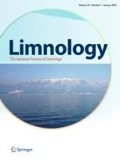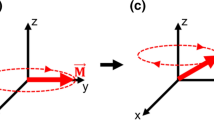Abstract
Distributions of molecular size and fluorescence properties of dissolved organic matter (DOM) in the Lake Biwa and Lake Baikal watersheds were investigated using the cross-flow ultrafiltration technique and three-dimensional fluorescence measurements. From the fluorescence properties, protein-like substances were usually found in the 0.1 μm-GF/F fraction (the Durapore membrane retentate of the GF/F filtrate) of the lake DOM. The results indicated autochthonous production of protein-like organic-matters in the lake environment. Fulvic acid (FA)-like components were composed of two fractions with respect to fluorescence properties and molecular size. Two FA-like fluorescence peaks, which showed different fluorescence peak positions in the excitation-emission matrix (EEM), were partly fractionated by the molecular size of 5000 daltons (5 kDa). The FA-like fluorescence peak position of the <5-kDa fraction was observed at the shorter wavelength region compared with that of the fraction between 5 kDa and 0.1 μm (5 kDa20.1 μm fraction). A blue shift of the FA-like fluorescence peak position as well as a decrease in the molecular size of the DOM was observed in lake samples. The relative contribution of the <5 kDa fraction to the DOC concentration was high in lake waters (68%–79%) compared with river waters (44%–68%), suggesting characteristic changes in molecular size between riverine and lacustrine DOM. DOM of the 5 kDa–0.1 μm fraction was relatively higher in river waters than in lake waters. These findings coincided with in situ distributions of the fluorescence properties and molecular size of DOM found in both stream and lake environments. These results indicate that FA-like substances from forested watersheds are decomposed qualitatively and quantitatively in the river-lake environment by photochemical and biological processes.
Similar content being viewed by others
References
Amon RMW, Benner R (1994) Rapid cycling of high-molecular-weight dissolved organic matter in the ocean. Nature (Lond) 369:549–552
Amon RMW, Benner R (1996) Photochemical and microbial consumption of dissolved organic carbon and dissolved oxygen in the Amazon River system. Geochim Cosmochim Acta 60:1783–1792
Bertilsson S, Allard B (1996) Sequential photochemical and microbial degradation of refractory dissolved organic matter in a humic freshwater system. Arch Hydrobiol Spec Issues Adv Limnol 48:133–141
Buffam I, Galloway JN, Blum LK, McGlathery KJ (2001) A stormflow/baseflow comparison of dissolved organic matter concentrations and bioavailability in an Appalachian stream. Biogeochemistry 53:269–306
Chen RF, Bada JL (1992) The fluorescence of dissolved organic matter in seawater. Mar Chem 37:191–222
Coble PG (1996) Characterization of marine and terrestrial DOM in seawater using excitation-emission matrix spectroscopy. Mar Chem 51:325–346
Coble PG, Schultz CA, Mopper K (1993) Fluorescence contouring analysis of DOC intercalibration experiment samples: a comparison of techniques. Mar Chem 41:173–178
Del Castillo CE, Coble PG, Morell JM, López JM, Corredor JE (1999) Analysis of the Orinoco River plume by absorption and fluorescence spectroscopy. Mar Chem 66:35–51
Determann S, Reuter R, Wagner P, Willkomm R (1994) Fluorescent matter in the eastern Atlantic Ocean. Part 1: Method of measurement and near-surface distribution. Deep-Sea Res I 41:659–675
Determann S, Lobbes JM, Reuter R, Rullkötter J (1998) Ultraviolet fluorescence excitation and emission spectroscopy of marine algae and bacteria. Mar Chem 62:137–156
Fukushima Y (1988) A model of river flow forecasting for a small forested mountain catchment. Hydrol Process 2:167–185
Guo L, Santschi PH (1997) Isotopic and elemental characterization of colloidal organic matter from the Chesapeake Bay and Galveston Bay. Mar Chem 59:1–15
Guo L, Santschi PH, Warnken KW (1995) Dynamics of dissolved organic carbon (DOC) in oceanic environments. Limnol Oceanogr 40:1392–1403
Guo L, Santschi PH, Cifuentes LA, Trumbore SE, Southon J (1996) Cycling of high-molecular-weight dissolved organic matter in the Middle Atlantic Bight as revealed by carbon isotopic (13C and 14C) signatures. Limnol Oceanogr 41:1242–1252
Hayakawa K, Sekino T, Yoshioka T, Maruo M, Kumagai M (2003) Dissolved organic carbon and fluorescence in Lake Hovsgol: factors reducing humic content of the lake water. Limnology 4:25–33
Hayase K, Yamamoto M, Nakazawa I, Tsubota H (1987) Behavior of natural fluorescence in Sagami Bay and Tokyo Bay, Japan: vertical and lateral distribution. Mar Chem 20:265–276
Hessen DO (1992) Dissolved organic carbon in a humic lake: effects on bacterial production and respiration. Hydrobiology 229:115–123
Hoge FE, Vodacek A, Blough NV (1993) Inherent optical properties of the ocean: retrieval of the absorption coefficient of chromophoric dissolved organic matter from fluorescence measurements. Limnol Oceanogr 38:1394–1402
Katsuyama M, Ohte N (2002) Determining the sources of stormflow from the fluorescence properties of dissolved organic carbon in a forested headwater catchment. J Hydrol 268:192–202
Kieber DJ, McDaniel J, Mopper K (1989) Photochemical source of biological substrates in sea water: implications for carbon cycling. Nature (Lond) 341:637–639
Malcolm RL (1985) Geochemistry of stream fulvic and humic substances. In: Aiken GR, Mcknight DM, Wershaw RL, MacCarthy P (eds) Humic substances in soil, sediment, and water: geochemistry, isolation, and characterization. Wiley, New York, pp 181–209
Mannino A, Harvey HR (2000) Biochemical composition of particles and dissolved organic matter along an estuarine gradient: sources and implications for DOM reactivity. Limnol Oceanogr 45:775–788
Matthews BJH, Jones AC, Theodorou NK, Tudhope AW (1996) Excitation-emission-matrix fluorescence spectroscopy applied to humic acid bands in coral reefs. Mar Chem 55:317–332
Mopper K, Schultz CA (1993) Fluorescence as a possible tool for studying the nature and water column distribution of DOC components. Mar Chem 41:229–238
Mopper K, Zhou X, Kieber RJ, Kieber DJ, Sikorski RJ, Jones RD (1991) Photochemical degradation of dissolved organic carbon and its impact on the oceanic carbon cycle. Nature (Lond) 353:60–62
Mopper K, Feng Z, Bentjen SB, Chen RF (1996) Effects of cross-flow filtration on the absorption and fluorescence properties of seawater. Mar Chem 55:53–74
Moran MA, Zepp RG (1997) Role of photoreactions in the formation of biologically labile compounds from dissolved organic matter. Invited review. Limnol Oceanogr 42:1307–1316
Moran MA, Sheldon WMJr, Zepp RG (2000) Carbon loss and optical property changes during long-term photochemical and biological degradation of estuarine dissolved organic matter. Limnol Oceanogr 45:1254–1264
Mostofa KMG, Sakugawa H (2003) Spatial and temporal variation of hydrogen peroxide in stream and river waters: effect of photobio-physio-chemical processes of aquatic matters. In: Abstracts of the 13th annual V.M. Goldschmidt conference. Geochim Cosmochim Acta Suppl 67(18S):A309
Mostofa KMG, Honda Y, Sakugawa H (2005a) Dynamics and optical nature of fluorescent dissolved organic matter in river waters in Hiroshima Prefecture, Japan. Geochem J 39:257–271
Mostofa KMG, Yoshioka T, Konohira E, Tanoue E, Hayakawa K, Takahashi M (2005b) Three-dimensional fluorescence as a tool for investigating the dynamics of dissolved organic matters in the Lake Biwa watershed. Limnology 6:101–115
Münster U, Salonen K, Tulonen T (1999) Decomposition. In: Keskitalo J, Eloranta P (eds) Limnology of humic waters. Backhuy, Leiden, pp 225–263
Nagata T, Takai K, Kawanobe K, Kim D-S, Nakazato R, Guselnikova N, Bondarenko N, Mologawaya O, Kostrnova T, Drucker V, Satoh Y, Watanabe Y (1994) Autotrophic picoplankton in southern Lake Baikal: abundance, growth and grazing mortality during summer. J Plankton Res 16:945–959
Nakanishi M, Sekino T, Kimoto T, Tsuda R, Kumagai M (1999) A hypothesis on formation of the subsurface chlorophyll maximum observed in Lake Biwa in September of 1994. Jpn J Limnol 60:125–137
Ohte N, Tokuchi N, Suzuki M (1995) Biogeochemical influences on the determination of water chemistry in a temperate forest basin: factors determining the pH value. Water Resour Res 31:2823–2834
Parlanti E, Wörz K, Geoffroy L, Lamotte M (2000) Dissolved organic matter fluorescence spectroscopy as a tool to estimate biological activity in a coastal zone submitted to anthropogenic inputs. Org Geochem 31:1765–1781
Peuravuori J, Pihlaja K (1999) Some approaches for modeling of dissolved aquatic organic matter. In: Keskitalo J, Eloranta P (eds) Limnology of humic waters. Backhuy, Leiden, pp 11–39
Romankevich EA (1984) Geochemistry of organic matter in the ocean. Springer-Verlag, Berlin
Santschi PH, Guo L, Baskaran M, Trumbore S, Southon J, Bianchi TS, Honeyman B, Cifuentes L (1995) Isotopic evidence for the contemporary origin of high-molecular weight organic matter in oceanic environments. Geochim Cosmochim Acta 59:625–631
Schindler DW, Curtis PJ, Parker BR, Stainton MP (1996) Consequences of climate warming and lake acidification for UV-B penetration in North American boreal lakes. Nature (Lond) 379:705–708
Schindler DW, Curtis PJ, Bayley SE, Parker BR, Beaty KG, Stainton MP (1997) Climate-induced changes in the dissolved organic carbon budgets of boreal lakes. Biogeochemistry 36:9–28
Senesi N (1990) Molecular and quantitative aspects of the chemistry of fulvic acid and its interactions with metal ions and organic chemicals. Part II. The fluorescence spectroscopy approach. Anal Chim Acta 232:77–106
Suzuki Y, Nagao S, Nakaguchi Y, Matsunaga T, Muraoka S, Hiraki K (1997) Spectroscopic properties of fluorescent substances in natural waters (1). Chikyukagaku (Geochemistry) 31:171–180
Suzuki Y, Nakaguchi Y, Hiraki K, Nagao S, Kudo M, Kimura M (1998) Characteristics of the fluorescent substances in the Yodo River system by three-dimensional excitation emission matrix spectroscopy (in Japanese with English abstract). Chikyukagaku (Geochemistry) 32:21–30
Tanoue E (1999) Dissolved protein and its origin. In: Dynamics of dissolved organic matter. The report of the contract research with the Lake Biwa Research Institute, Shiga Prefecture (in Japanese). Lake Biwa Research Institute, Japan, pp 3–29
Tranvik L (1992) Allochthonous dissolved organic matter as an energy source for pelagic bacteria and the concept of the microbial loop. Hydrobiologia 229:107–114
Tranvik L, Olofsson H, Bertilsson S (1999) Photochemical effects on bacterial degradation of dissolved organic matter in lake water. In: Bell CR, Brylinski M, Johnson-Green P (eds) Microbial biosystems: new frontiers. Atlantic Canada Society for Microbial Ecology, Halifax, Canada, pp 193–200
Waiser MJ, Robarts RD (2000) Changes in composition and reactivity of allochthonous DOM in a prairie saline lake. Limnol Oceanogr 45:763–774
Wetzel RG, Hatcher PG, Bianchi TS (1995) Natural photolysis by ultraviolet irradiation of recalcitrant dissolved organic matter to simple substrates for rapid bacterial metabolism. Limnol Oceanogr 40:1369–1380
Wu F, Tanoue E (2001) Molecular mass distribution and fluorescence characteristics of dissolved organic ligands for copper (II) in Lake Biwa, Japan. Org Geochem 32:11–20
Yoshioka T, Ueda S, Khodzher T, Bashenkhaeva N, Korovyakova I, Sorokovikova L, Gorbunova L (2002) Distribution of dissolved organic carbon in Lake Baikal and its watershed. Limnology 3:159–168
Author information
Authors and Affiliations
Corresponding author
Rights and permissions
About this article
Cite this article
Yoshioka, T., Mostofa, K.M.G., Konohira, E. et al. Distribution and characteristics of molecular size fractions of freshwater-dissolved organic matter in watershed environments: its implication to degradation. Limnology 8, 29–44 (2007). https://doi.org/10.1007/s10201-006-0194-9
Received:
Accepted:
Published:
Issue Date:
DOI: https://doi.org/10.1007/s10201-006-0194-9




